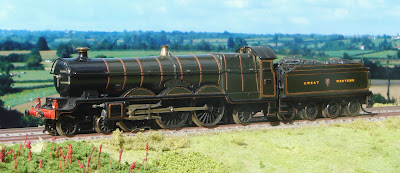Many years ago, while living in London, I began construction of a large fixed N-gauge layout of Totnes station, the River Dart and estuary, Dainton tunnel and the Ashburton branch. The whole thing was an L-shape, about 4m by 4.5m and 1m deep. It was approaching completion when we moved down to Somerset some twenty years ago. Despite its massive size, it survived the move, minus the Ashburton terminus, which had to be surgically removed to fit into the loft. A remodelled Ashburton now forms the basis of a small independent layout that has been going the exhibition rounds for the last ten years.
All photographs in this post © Tony Wright
 General view of the layout
General view of the layout
A view of the River Dart and rail bridge with the station beyond. The Ashburton Branch runs towards the foreground.
 Totnes station
Totnes station
A general view of Totnes station from the south with the River Dart estuary beyond. A 28xx class hauls a down coal train towards Plymouth.
After desultory progress towards completing the Totnes layout, I came to the conclusion that I wasn’t likely to generate enough enthusiasm to finish the work. So, about five years ago, I decided to remake it, concentrating on the station, town and river, on new baseboards. At least the result would be transportable and the pressure of getting things into a suitable state for exhibition would perhaps generate sufficient incentive to complete the tasks. The result is a layout about 3m by 1.7m, with a simple double-track oval plan. It comprises six new track boards and two scenic boards to fill-in the centre and a panoramic back scene. Although I had to take some substantial liberties with geography, I hope that the result retains the character of the locality.

Totnes Plains
The Dart estuary with the Quay branch
Baseboard construction is of 4mm ply perimeter and cross beams, reinforced with stripwood and thickened at the board joints. Board junctions are located by loose-pin hinges and joined with M10 bolts with wing nuts. The layout is supported on a fold-out box construction which provides storage for many of the ancillary items – power supply, tools, etc. Lighting is by a concentrated array of tungsten halogen lamps on a high single pole. The track bed is 9mm MDF on a ply spine beam and the track throughout is Peco code 55, carefully ballasted with fine sand. Turnouts are again Peco, with Seep motors. Everything is controlled from a plug-in panel with separate Gaugemaster controllers for the up and down lines.

Dainton tunnel
County of Cornwall with a down stopping passenger train emerging from Dainton Tunnel.
The ground levels of the scenic areas are Sundeala insulation board, cut and glued to form a three-dimensional monocoque, then coated with filler and grassed with stuck-down lint fibres. The River Dart in the foreground is of casting resin while, in the background, I’ve used painted and varnished MDF.
 Totnes station
Totnes station
An up livestock train emerging from beneath the main road bridge, hauled by a Dean goods.
For me, the good news is that almost all the buildings and many civil engineering structures, trees and details were salvaged from the earlier layout. Generally, buildings are scratch-built and made of mounting board with the late lamented BuilderPlus stone and brick papers. Trees and foliage are largely Woodland Scenics and Heka on simple wire armatures, with some proprietary specimen trees in the foreground. Block planting in the background is formed with teased-out filter fabric on wire mesh structures. The backscene panorama is of 2mm MDF, fretted to shape, in front of a separate painted sky backdrop.

Totnes station
A 517 class 0-4-2 tank with a down train of four and six wheel coaches passes under the footbridge. The station pilot, a 45xx, waits on the goods shed road, ready to bank down goods over Rattery Bank. The original station had overall roofs over the up and down platform roads, probably demolished during the major remodelling works of 1932.
The rolling stock is also largely already available from the earlier layouts. The stable of over 20 locomotives are mainly scratch-built or heavily modified proprietary models. Coaching stock is a combination of proprietary models and kits and wagons are proprietary, all weathered. The operating programme is still in its infancy but is based on prototypical movements of the 1920s and 1930s.

Steamer Quay
The river steamer Berry Castle with the Town Bridge beyond.
Signals remain absent – there are dozens within the Totnes station limits and I need to make most of them operating. That should keep me busy for a few months.

Castle House
Beyond Castle House and gardens, an up livestock train emerges from beneath the main road bridge, hauled by a saddle tank.

The River Dart and the mill tail race, separated by a small park – The Island – meet at St Peter’s Quay Pool.
 Unloading timber at the Town Quay Photo JBS
Unloading timber at the Town Quay Photo JBS














































